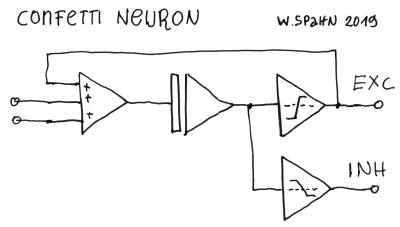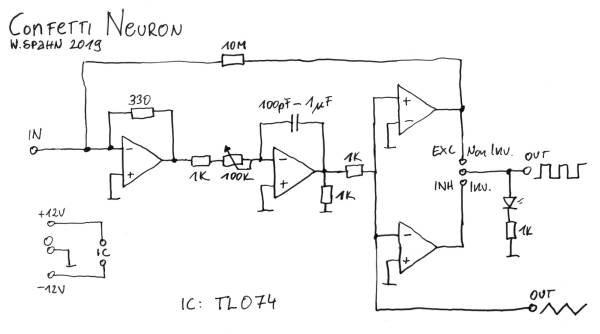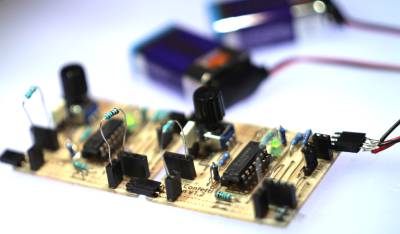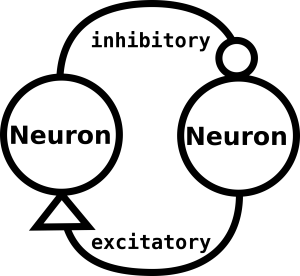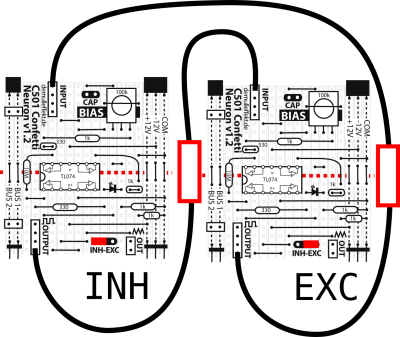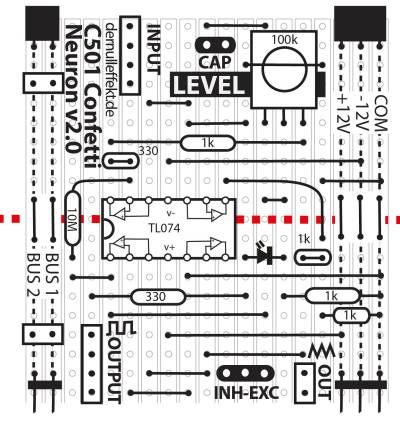Table of Contents
Confetti501 Confetti Neuron
Confetti Neurons are special modules to implement an analog artificial neural network into the multi-connect system of the Analog Computer Confetti.
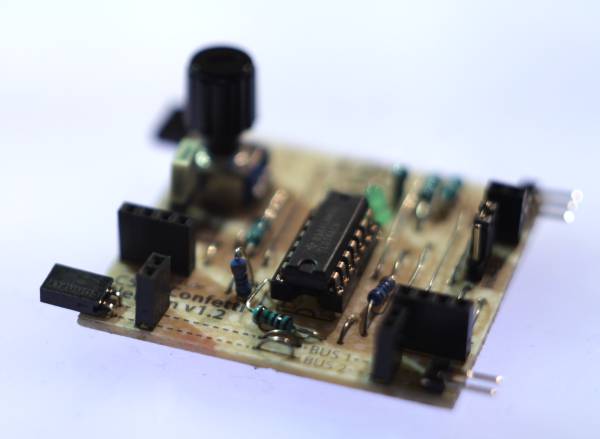
Check out the Third Edition - Handmade Electronic Music by Nicolas Collins. The chapter “Sounds from Neural Networks” by Wolfgang Spahn is about the Confetti Neuron.
The Confetti Neuron is the successor and a further development of the Pop Neuron. It's design focus is on a better sound quality, less power consumption and easier handling than the Pop Neuron.
The Circuit
The basic idea for the circuit of the Confetti Neuron was to build a circuit out of four different Confetti modules: a summing amplifier, an integrator and a comparator, depending on the condition of the neuron, a non inverting comparator for the excitatory and an inverting comparator for the inhibitory.
These four modules combined behaved exactly like Shun-Ichi Amari had described* in his neural model that should explain our hear beat. They would fire or not fire (outputs +12V or -12V) when a certain input level (action potential) was reached.
The option to change the integrator circuit on the board by plugging in capacitors with different values (from 100pF up to 1000µF) and the option to connect at the input as many different sources as one wants makes the Confetti Neuron highly flexible to use in all kind of applications.
Thus one can use the boards in combination with the plug-in slots of all the analog computer module to create an analog neural network. In adding resistors and capacitors to it one can build an excitatory (EXC) or an inhibitory (INH) neuron out of a Confetti Neuron 501 module, depending on the jumper setting.
*Dynamics of Pattern Formation in Lateral-Inhibition Type Neural Fields by Shun-Ichi Amari
Schematic
Patching
The core ides of the analog computer Confetti was to provide a highly flexible system for using and combining all individual boards of this system. One can patch all modules via a build in bus or in using the patching wires in combination with the sockets on the boards. With these ideas also realized in the Confetti Neuron, one can easily use two different neurons to build an oscillator, or with some more neurons one can build a whole analog artificial network.
For patching some extra components like for example potentiometer or diodes one can use the Confetti302 Breadboard to do so.
Neural Sound Synthesis
One can use these neurons to generate pattern and structures for all kind of sequencers and also for synthesize sound for musical instruments similar like the one David Tutor used for his Neural Synthesis Nos. 6-9 in 1993. A description of his work by Forrest Warthman and Mimi Johnson is on the artist web-side: The Neural Network Synthesizer. His neural synthesizer was based on a RC-circuit in combination of the 80170NX Electrically Trainable Analog Neural Network chip by Intel.
Shun-Ichi Amaris neurons have the ability to oscillate when one puts two together and they are also capable to synchronize with each other.
To patch two neurons for an oscillator one has to connect the output of the first neuron to the input of the second neuron and vice versa. Depending on the frequency various resisters could be used. The value should be more than 5kOhm and could be up to 12MOhm. The capacitor on the board should have a value from 100pF to 1µF.
One can use for example for a good sounding oscillator a resistor value of 100kOhm and a capacitor value of 3.9nF.
To change the frequency one can use a potentiometer instead of the two resistors. For a good result one should use a 2MOhm stereo potentiometer.
Patching a Ring of Oscillation
Synchronization of two Confetti Oscillators
Paper PCB
Parts
- Resistors:
- 4x 1 kOhm
- 2x 330 kOhm
- 1x 10 MOhm
- Capacitors:
- 1x 100pF - 1000µF
- Diodes:
- 1x LED
- Semiconductors
- 1x TL074 OpAmp
- Mechanical:
- 1x IC socket, 14pins
- 1x 3 pin strip
- 1x jumpers
- 3x 2 pin header, female
- 2x 4 pin header, female
- 1x 2 pin socket header, female
- 2x pin header, female 90° 1×3, 1×2
- 2x pin header, male 90° 1×3, 1×2
- Potentiometers:
- 1x 100 kOhm
Acknowledge
These oscillator and network behave similar to the one described in Dynamics of Pattern Formation in Lateral-Inhibition Type Neural Fields by Shun-Ichi Amari. The implementation of the analog neuron was described in Implementation of Artificial Neural Oscillators in 2009 by Pavlo V. Tymoshchuk, Yuriy I. Paterega.
One important origin of the Confetti Neuron is the bicore circuit of the BEAM.
A digital implementation on syncing and desyncing processes of two mutually coupled systems one can find on Netze/Networks Neural Oscillators by Lab3 - Laboratory for Experimental Computer Science at the Academy of Media Arts Cologne.
An other example of an electric implementation of an analog neuron for controlling robots one can find in Neurodynamische Module zur
Bewegungssteuerung autonomer
mobiler Roboter by Manfred Hild.
License
The Confetti501 Confetti Neuron was designed by Wolfgang Spahn 2019-20.
It is licensed under a Creative Commons Attribution-NonCommercial-ShareAlike 4.0 International License.

